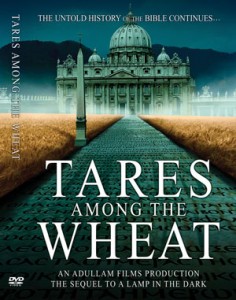 People in the Hebrew Roots Movement (HRM) like to celebrate the Jewish feast days as described in the Torah. This seems fine to me unless someone is teaching that they are required or that not celebrating them somehow diminishes one’s spiritual stature. Unfortunately, many popular teachers do just that. The feasts of Israel are those described in Leviticus 23. The three pilgrimage feasts—the Passover, the Feast of Weeks, and the Feast of Tabernacles—demanded that every male Israelite travel to Jerusalem to worship at the temple. The Passover and the Feast of Unleavened Bread are closely related and ran consecutively (Lev 23:4–8). The Feast of Weeks (Pentecost) followed seven weeks later, and connected the Passover of the exodus with the conquest. Both Passover and Pentecost were practiced by early Christians because Christ was crucified at the Passover, and the Holy Spirit personally descended upon the disciples on Pentecost (Acts 2). The Bible ends with the anticipation of one final feast: the Marriage Supper of the Lamb (Rev 19:9).
People in the Hebrew Roots Movement (HRM) like to celebrate the Jewish feast days as described in the Torah. This seems fine to me unless someone is teaching that they are required or that not celebrating them somehow diminishes one’s spiritual stature. Unfortunately, many popular teachers do just that. The feasts of Israel are those described in Leviticus 23. The three pilgrimage feasts—the Passover, the Feast of Weeks, and the Feast of Tabernacles—demanded that every male Israelite travel to Jerusalem to worship at the temple. The Passover and the Feast of Unleavened Bread are closely related and ran consecutively (Lev 23:4–8). The Feast of Weeks (Pentecost) followed seven weeks later, and connected the Passover of the exodus with the conquest. Both Passover and Pentecost were practiced by early Christians because Christ was crucified at the Passover, and the Holy Spirit personally descended upon the disciples on Pentecost (Acts 2). The Bible ends with the anticipation of one final feast: the Marriage Supper of the Lamb (Rev 19:9).
Because Jesus fulfilled the Spring feasts: Passover-Pentecost with his death burial, resurrection, ascension and subsequent outpouring of the Holy Spirit. This leads many to suspect the Fall feasts: (Trumpets, Day of Atonement, Tabernacles) are connected to his second coming. This is somewhat compelling but not necessary. It is speculative. God nowhere promised that Jesus would return on a certain feast day and certainly never implied that observing them is required to be found in good stead when he returns. Yet Rob Skiba instructs his Virtual House Church that this is the case and those who do not celebrate them have diminished status.
While the feasts of the Lord are interesting for prophetic study, some have wandered away from biblical theology by implying new covenant believers are required to observe the Mosaic laws regarding feast observance. Russ Houck writes that Constantine, “single-handedly stopped the New Church from observing the feasts of the Lord ordained by the Bible. Robbed of its Hebrew roots, the disconnected church became paganistic in spirit and anti-biblical in its customs.”[1] But is this really so? The teaching of the New Testament is that old covenant feast observance is no longer required. This error was dealt with by Paul when false teachers in Colasse:
“I say this in order that no one may delude you with plausible arguments. For though I am absent in body, yet I am with you in spirit, rejoicing to see your good order and the firmness of your faith in Christ. Therefore, as you received Christ Jesus the Lord, so walk in him, rooted and built up in him and established in the faith, just as you were taught, abounding in thanksgiving. See to it that no one takes you captive by philosophy and empty deceit, according to human tradition, according to the elemental spirits of the world, and not according to Christ.”(Col 2:4–8)
This is exactly what is re-occuring in our own context with teachers putting folks back under the obsolete ceremonial law by implying that feast observance is needed for spiritual advancement and sanctification. There are 3 types of OT law 1) ceremonial; 2) civil; 3) moral. While God’s moral character does not change, the old covenant stipulations were only for Israelites under that conditional covenant. The conditions were violated and the old covenant was replaced by the new covenant. Rob Skiba implies that Christians should be feast observant to be “at the right place at the right time when Jesus shows up” at the 1:07:49 mark in the video below:
He misapplies Matthew 5:16-19 (as explained by Douglas Moo below) and then at the 1:10:05 mark uses verse 19 to argue that those who disagree with him are going to be “janitors in heaven.” While I am sure that hard-working custodians take exception with Rob’s degradation of their work, Skiba implies that non-observance diminishes one’s status with God. I say balderdash. The idea that there is a spiritual reward for keeping dietary or ceremonial laws is a false teaching, it is a misapplication of scripture. Paul addressed the feasts specifically:
“Therefore let no one pass judgment on you in questions of food and drink, or with regard to a festival or a new moon or a Sabbath.” (Col 2:16)
Paul was addressing the false teachers in Colasse who were advocating a number of Jewish observances, arguing that they were essential for spiritual advancement.
“These are a shadow of the things to come, but the substance belongs to Christ.”(Col 2:17)
The old covenant observances pointed to a future reality that was fulfilled in the Lord Jesus Christ (cf. Heb. 10:1). Hence, Christians are no longer under the Mosaic covenant (cf. Rom. 6:14–15; 7:1–6; 2 Cor. 3:4–18; Gal. 3:15–4:7). Christians are no longer obligated to observe OT dietary laws (“food and drink”) or festivals, holidays, and special days (“a festival … new moon … Sabbath,” Col. 2:16), for what these things foreshadowed has been fulfilled or will be fulfilled in Christ. You will not be demoted for not celebrating as a Torah observant Jew.
Hebrews 8-10 explains very clearly that Christ’s atoning death on the cross was the end of the law and it is now obsolete for everyone.
“In speaking of a new covenant, he makes the first one obsolete. And what is becoming obsolete and growing old is ready to vanish away.”(Heb 8:13)
As to Rob’s eisegesis of Matthew 5:17-19, atheists and homosexuals also like to use this passage to ask why Christians no longer stone people or why we eat shellfish and pork or wear clothes made of different fabrics. The answer we give them is the same one we give to the HRM, those laws are now obsolete. I guess we should ask our feast-requirers why they don’t also stone people? It’s part of the same covenant stipulations. So what did Jesus mean by saying this:
“Do not think that I have come to abolish the Law or the Prophets; I have not come to abolish them but to fulfill them. For truly, I say to you, until heaven and earth pass away, not an iota, not a dot, will pass from the Law until all is accomplished.”(Mt 5:17–18)
Jesus “fulfills” all of the OT in that it all points to him, not only in its specific predictions of a Messiah but also in its sacrificial system, which looked forward to his great sacrifice of himself, this made the old obsolete (Hebrews 8:13). We are now concerned with “the law of Christ” as seen in Galatians 6:2. According to NT scholar Douglas Moo:
Christ has brought the OT law’s fulfillment. But the Christian is bound to “God’s law” (1 Cor 9:20–21; cf. “God’s commands” in 1 Cor 7:19 and 1 John 2:3-4 etc.). “God’s law” is not, however, the Mosaic Law, but “Christ’s law” (1 Cor 9:20–21; Gal 6:2), because it is to Christ, the fulfiller, the τέλος of the law (Rom 10:4), that the Christian is bound. In that “fulfillment” of the law, however, some of the Mosaic commandments are taken up and reapplied to the New Covenant people of God. Thus, while the Mosaic Law does not stand as an undifferentiated authority for the Christian, some of its individual commandments remain authoritative as integrated into the law of Christ. [2]
Christ’s death and resurrection changed everything — by emphasizing the Torah over the cross they are promoting error. The cross made a new paradigm, a new covenant! The New Covenant is celebrated by the Lord’s Supper which has supplanted the feast days.
“And likewise the cup after they had eaten, saying, “This cup that is poured out for you is the new covenant in my blood.” (Lk 22:20)
“In the same way also he took the cup, after supper, saying, “This cup is the new covenant in my blood. Do this, as often as you drink it, in remembrance of me.””(1 Co 11:25)“Therefore he is the mediator of a new covenant, so that those who are called may receive the promised eternal inheritance, since a death has occurred that redeems them from the transgressions committed under the first covenant.” (Heb 9:15) “and to Jesus, the mediator of a new covenant, and to the sprinkled blood that speaks a better word than the blood of Abel.” (Heb 12:24)
While the feasts make an interesting study and might have prophetic significance, Christians should first and foremost celebrate the new covenant with their a local church body rather than celebrating the Jewish feast days from an obsolete covenant.
[1] Russ Houck, Epidemic Examining the Infected Roots of Judaism and Christianity: How Do We Find God with All This Mess? (volume 1) (Corsicana, TX: Negev Publishing, 2012), 220.
[2]Douglas Moo, “The Law of Moses or the Law of Christ” in Continuity and Discontinuity: Perspectives on the Relationship Between the Old and New Testaments : Essays in Honor of S. Lewis Johnson, Jr. editors S. Lewis Johnson and John S. Feinberg,(Westchester, Ill.: Crossway Books, 1988), 208.




